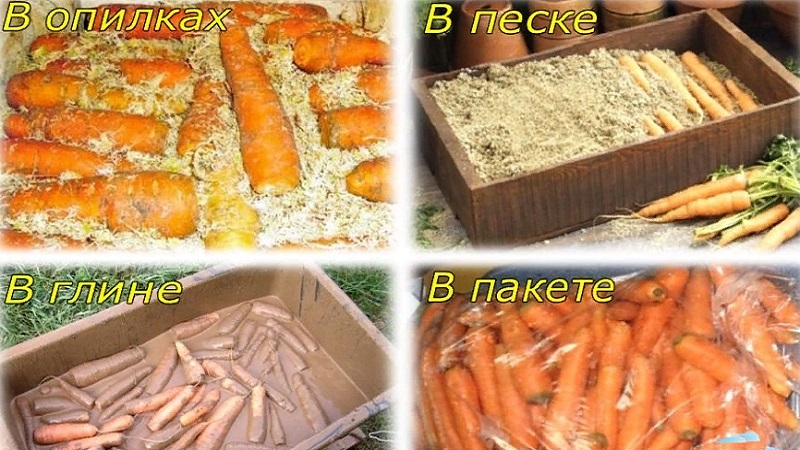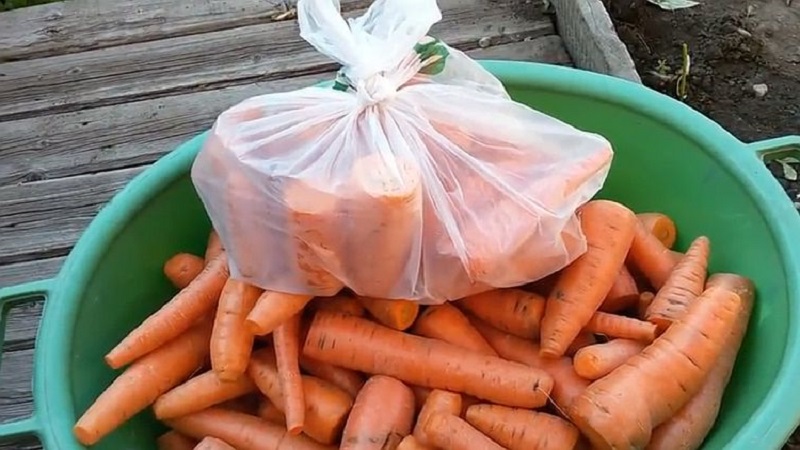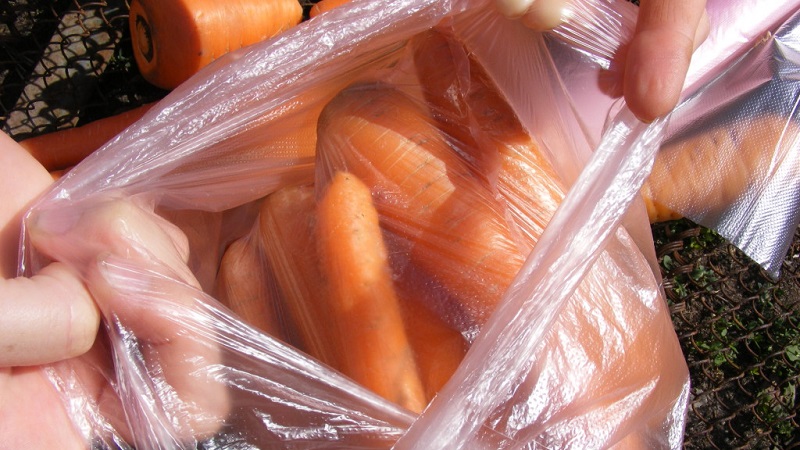Features of storing carrots in packages in winter in the underground
Carrots are used for cooking almost every day, so housewives try to keep them fresh for the winter. Depending on the region, the presence of a cellar, basement or other place, a suitable option for preserving vegetables is chosen. In the article, we will tell you in detail about such a method as storing carrots in bags for the winter in the underground.
The content of the article
Features of storing carrots in the cellar in winter
Cellar and the basement are the best places for storing carrots in winter... Here the vegetable can be stored from 6 to 12 months. To maintain freshness and juiciness, the temperature is maintained from 0 to + 3 ° C and humidity is 90-95%.

Vegetables are stored in the cellar in several ways:
- in sawdust - sawdust does not allow the carrots to dry out and at the same time they take away excess moisture;
- in sand - the sand must be dry and clean, the carrots are laid in rows and sprinkled;
- in wooden boxes in bulk - no more than 2-3 m high;
- in onion peel - the peel takes away excess moisture and prevents the growth of microorganisms and rotting;
- in plastic bags - a convenient way for short-term storage.
The room temperature should not fluctuate much... If necessary, disinfect the cellar with lime or copper sulfate.
Can it be stored in plastic bags, vacuum, plastic bags in the underground in winter
One of the options is the content of root crops in plastic bags and cellophane bags... Shelf life of carrots in this way is 4-5 months.
To preserve the crop longer in large bags, root crops are often examined and spoiled specimens are removed.... Store in plastic bags in small portions up to 3 kg. And vegetables will lie in vacuum bags for only 2-3 weeks, as they will quickly deteriorate due to the lack of air. The vacuum is used only for freezing vegetables.

Can be stored with beets
Carrots are stored with any other root vegetables, including beets... First, a layer of carrots is placed in the bag, then - beets. They have the same storage conditions.
Carrots, unlike beets, do not tolerate the neighborhood with potatoes and quickly begins to fade.
Attention! Root vegetables are kept as far away as possible from apples, which release ethylene when ripe, which leads to spoilage of carrots and beets.
Pros and cons of storage in cellophane bags, plastic bags, or vacuum bags
The advantages of such storage:
- can be stored in portions and taken from the cellar one at a time;
- simplicity of the storage procedure;
- ease of transportation - easier to carry in bags than in boxes.
Minuses:
- the likelihood of rotting is higher;
- the need to constantly monitor the temperature and humidity - when the temperature rises, "biological sleep" is interrupted, and carrots begin to germinate;
- the need to create conditions under which condensation does not form.

Storage preparation
Going to keep the roots in the cellar, choose varietiessuitable for long-term storage. The most famous:
Important for successful long-term storage timely harvest... Root crops are dug at an air temperature of + 4 ° C, since growth stops at this time. At sub-zero temperatures, gray rot may appear.
Before laying vegetables, dry and cool to 0 ° С... Putting warm roots into a cool cellar can spread rot.
Clean, dry, undamaged specimens are selected for storage... The tops are cut off, trying not to hurt the roots. Sort them by size. Small root vegetables are stored less and are used primarily for cooking. Long, large roots last longer.

Selected root vegetables are laid out in bags... Sugar bags 10 kg, large plastic bags 30 kg and ordinary plastic bags are suitable. Large bags are kept open to allow air to enter.
Cellophane bags are tied loosely and holes are made at the bottom of the bag for ventilation. Small bags are not filled tightly to allow air to circulate.
Reference. Carrots give off carbon dioxide. It accumulates a little in open bags, and it prevents the appearance of diseases. In closed bags, its concentration will be high and the carrots will go bad.
What problems may arise during storage
Hostesses face such difficulties when storing root vegetables in bags in a subfield:
- Excessive moisture. This problem can be eliminated by spreading moss, newspapers or lime nearby - they will absorb excess moisture.
- Condensation in bags. To prevent the bags do not close tightly and make holes in them. If condensation has formed, the carrots are sorted out, dried and placed in dry, clean bags.
- Rot formation. To avoid this, the ends of the carrots are dipped in ash when laying for storage.
When kept in large plastic bags, spoiled root vegetable is difficult to see and remove it in time. We have to sort out the root crops in bags once a week to monitor their condition.
Conclusion
Knowing simple methods, you can provide yourself with tasty, fresh carrots for the whole winter. Storage in plastic bags is a simple, hygienic, economical way. Its main disadvantage is relatively short shelf life - only 4-5 months.